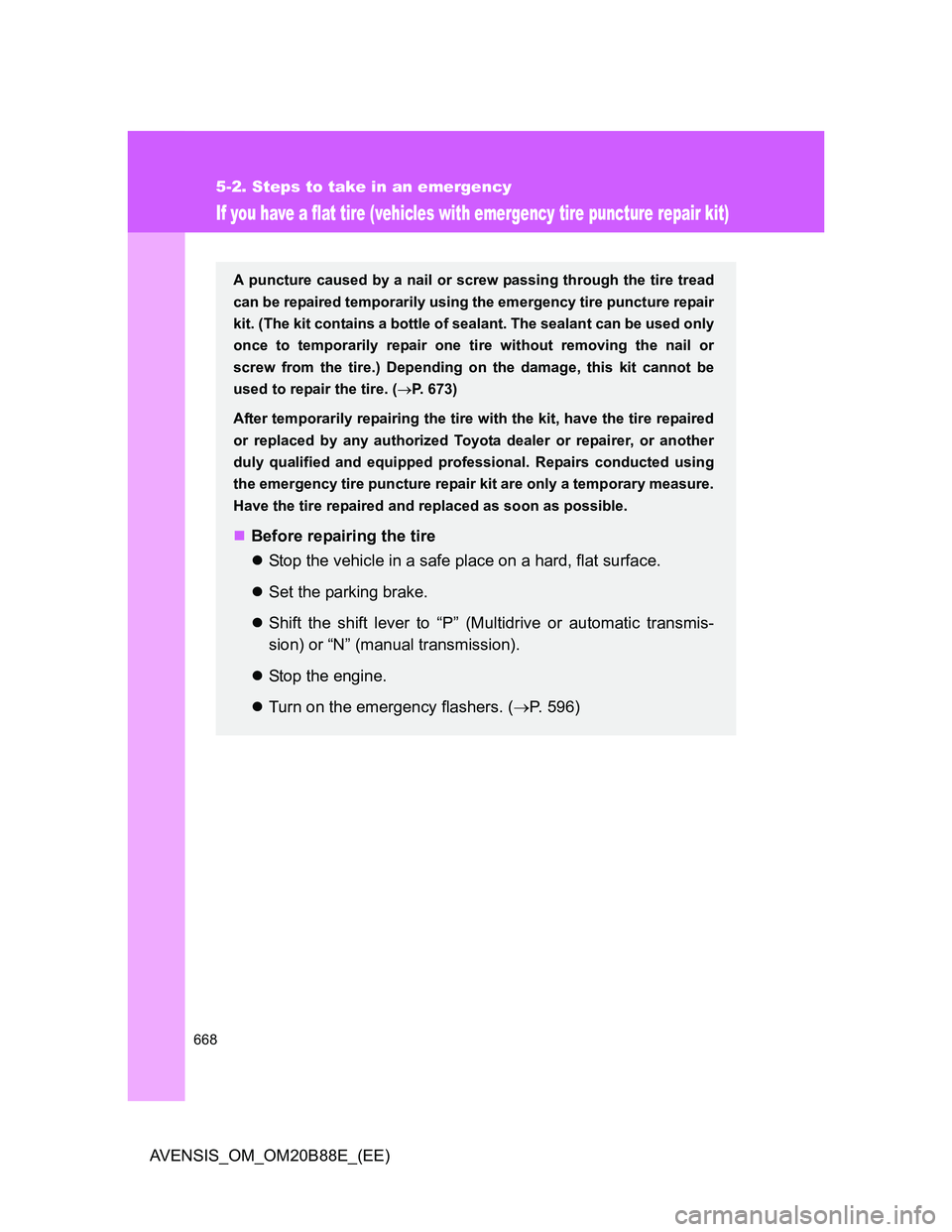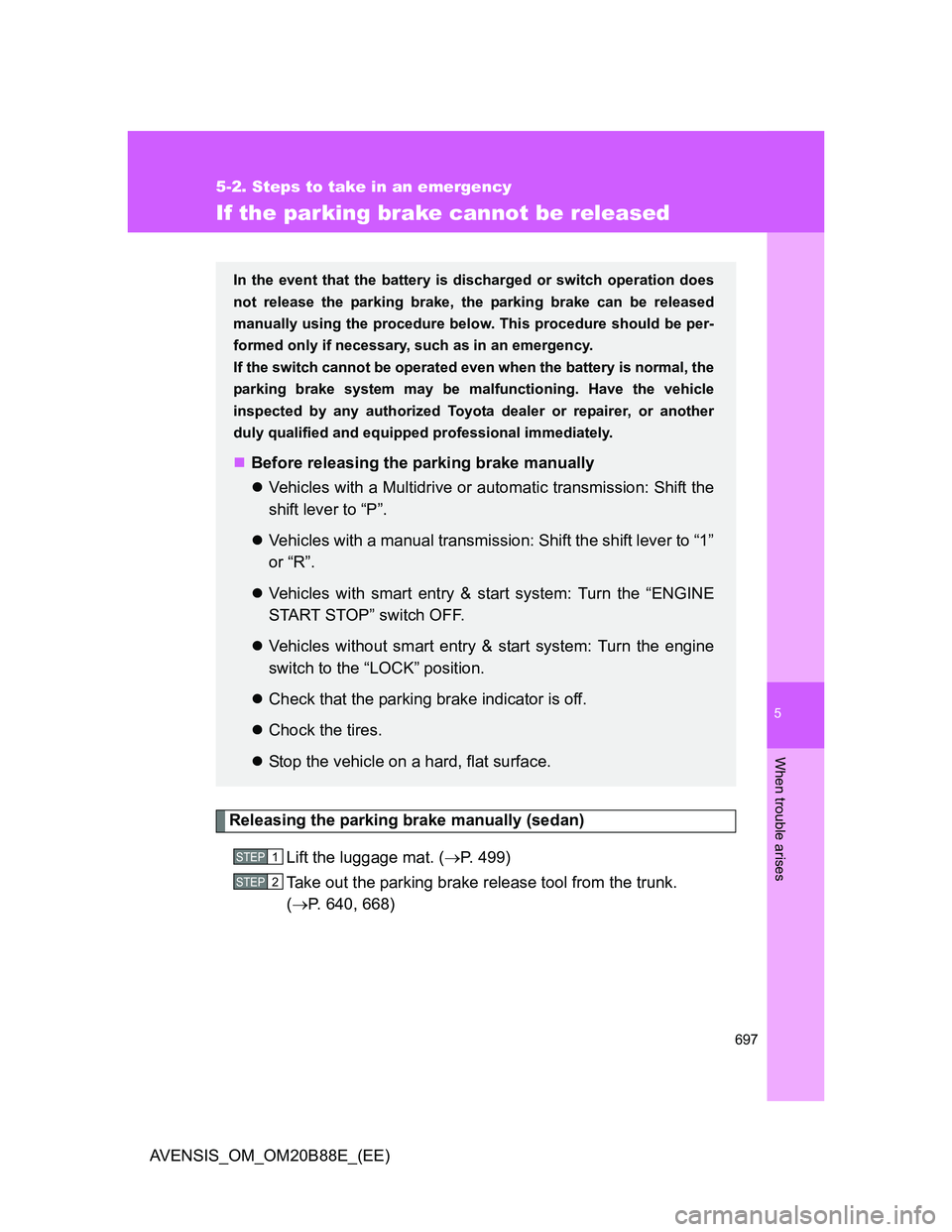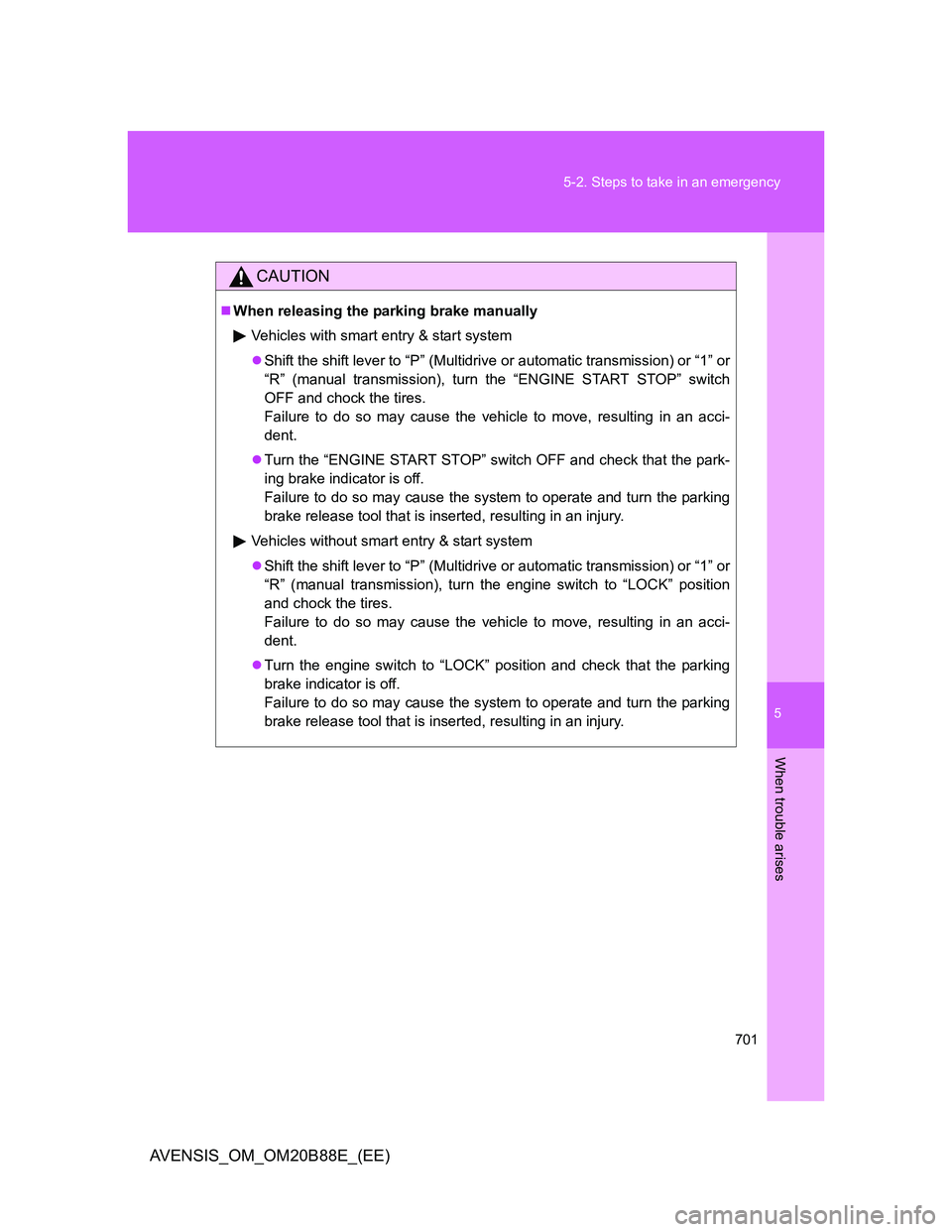Page 640 of 776
640
5-2. Steps to take in an emergency
AVENSIS_OM_OM20B88E_(EE)
If you have a flat tire (vehicles with a spare tire for sedan)
Remove the flat tire and replace it with the spare provided.
Before jacking up the vehicle
Stop the vehicle on a hard, flat surface.
Set the parking brake.
Shift the shift lever to “P” (Multidrive or automatic transmis-
sion) or “R” (manual transmission).
Stop the engine.
Turn on the emergency flashers. (P. 596)
Location of the spare tire, jack and tools
Vehicles with a compact spare tire
Parking brake
release tool
Towing eyeletWheel nut wrench
Spare tire
Jack
Jack handle
Page 654 of 776
654
5-2. Steps to take in an emergency
AVENSIS_OM_OM20B88E_(EE)
If you have a flat tire (vehicles with a spare tire for wagon)
Remove the flat tire and replace it with the spare provided.
Before jacking up the vehicle
Stop the vehicle on a hard, flat surface.
Set the parking brake.
Shift the shift lever to “P” (Multidrive or automatic transmis-
sion) or “R” (manual transmission).
Stop the engine.
Turn on the emergency flashers. (P. 596)
Location of the spare tire, jack and tools
Vehicles with a compact spare tire
Spare tire
Jack handle
Rear auxiliary
box
Jack
Wheel nut
wrench
Parking brake
release tool
To w i n g
eyelet
Page 668 of 776

668
5-2. Steps to take in an emergency
AVENSIS_OM_OM20B88E_(EE)
If you have a flat tire (vehicles with emergency tire puncture repair kit)
A puncture caused by a nail or screw passing through the tire tread
can be repaired temporarily using the emergency tire puncture repair
kit. (The kit contains a bottle of sealant. The sealant can be used only
once to temporarily repair one tire without removing the nail or
screw from the tire.) Depending on the damage, this kit cannot be
used to repair the tire. (P. 673)
After temporarily repairing the tire with the kit, have the tire repaired
or replaced by any authorized Toyota dealer or repairer, or another
duly qualified and equipped professional. Repairs conducted using
the emergency tire puncture repair kit are only a temporary measure.
Have the tire repaired and replaced as soon as possible.
Before repairing the tire
Stop the vehicle in a safe place on a hard, flat surface.
Set the parking brake.
Shift the shift lever to “P” (Multidrive or automatic transmis-
sion) or “N” (manual transmission).
Stop the engine.
Turn on the emergency flashers. (P. 596)
Page 697 of 776

5
697
5-2. Steps to take in an emergency
When trouble arises
AVENSIS_OM_OM20B88E_(EE)
If the parking brake cannot be released
Releasing the parking brake manually (sedan)
Lift the luggage mat. (P. 499)
Take out the parking brake release tool from the trunk.
(P. 640, 668)
In the event that the battery is discharged or switch operation does
not release the parking brake, the parking brake can be released
manually using the procedure below. This procedure should be per-
formed only if necessary, such as in an emergency.
If the switch cannot be operated even when the battery is normal, the
parking brake system may be malfunctioning. Have the vehicle
inspected by any authorized Toyota dealer or repairer, or another
duly qualified and equipped professional immediately.
Before releasing the parking brake manually
Vehicles with a Multidrive or automatic transmission: Shift the
shift lever to “P”.
Vehicles with a manual transmission: Shift the shift lever to “1”
or “R”.
Vehicles with smart entry & start system: Turn the “ENGINE
START STOP” switch OFF.
Vehicles without smart entry & start system: Turn the engine
switch to the “LOCK” position.
Check that the parking brake indicator is off.
Chock the tires.
Stop the vehicle on a hard, flat surface.
STEP1
STEP2
Page 701 of 776

5
701 5-2. Steps to take in an emergency
When trouble arises
AVENSIS_OM_OM20B88E_(EE)
CAUTION
When releasing the parking brake manually
Vehicles with smart entry & start system
Shift the shift lever to “P” (Multidrive or automatic transmission) or “1” or
“R” (manual transmission), turn the “ENGINE START STOP” switch
OFF and chock the tires.
Failure to do so may cause the vehicle to move, resulting in an acci-
dent.
Turn the “ENGINE START STOP” switch OFF and check that the park-
ing brake indicator is off.
Failure to do so may cause the system to operate and turn the parking
brake release tool that is inserted, resulting in an injury.
Vehicles without smart entry & start system
Shift the shift lever to “P” (Multidrive or automatic transmission) or “1” or
“R” (manual transmission), turn the engine switch to “LOCK” position
and chock the tires.
Failure to do so may cause the vehicle to move, resulting in an acci-
dent.
Turn the engine switch to “LOCK” position and check that the parking
brake indicator is off.
Failure to do so may cause the system to operate and turn the parking
brake release tool that is inserted, resulting in an injury.
Page 707 of 776

5
707 5-2. Steps to take in an emergency
When trouble arises
AVENSIS_OM_OM20B88E_(EE)
Starting the engine
Vehicles with a Multidrive or automatic transmission: Shift the
shift lever to “P” and apply the brakes.
Vehicles with a manual transmission: Shift the shift lever to
“N” and depress the clutch pedal.
Touch the Toyota emblem side of
the electronic key to the
“ENGINE START STOP” switch.
An alarm will sound to indicate
that the start function cannot
detect the electronic key that is
touched to the “ENGINE START
STOP” switch if any of the doors
is opened while the key is
touched to the switch.
Press the “ENGINE START STOP” switch within 10 seconds
after the buzzer sounds, keeping the brake pedal (Multidrive
or automatic transmission) or clutch pedal (manual transmis-
sion) depressed.
In the event that the “ENGINE START STOP” switch still cannot be
operated, contact any authorized Toyota dealer or repairer, or another
duly qualified and equipped professional.
STEP1
STEP2
STEP3
Page 708 of 776

708 5-2. Steps to take in an emergency
AVENSIS_OM_OM20B88E_(EE)
Stopping the engine
Shift the shift lever to “P” (Multidrive or automatic transmission) or “N” (man-
ual transmission) and press the “ENGINE START STOP” switch as you nor-
mally do when stopping the engine.
Replacing the key battery
As this procedure is a temporary measure, it is recommended that the elec-
tronic key battery be replaced immediately when the battery depletes.
(P. 556)
Alarm
Using the mechanical key to lock the doors will not set the alarm system.
If a door is unlocked using the mechanical key when the alarm system is set,
the alarm may be triggered. (P. 138)
Changing “ENGINE START STOP” switch modes
Automatic transmission
Within 10 seconds of the buzzer sounding, release the brake pedal and
press the “ENGINE START STOP” switch.
The engine does not start and modes will be changed each time the
switch is pressed. (P. 202)
Manual transmission
Within 10 seconds of the buzzer sounding, release the clutch pedal and
press the “ENGINE START STOP” switch.
The engine does not start and modes will be changed each time the
switch is pressed. (P. 202)
Page 713 of 776

5
713 5-2. Steps to take in an emergency
When trouble arises
AVENSIS_OM_OM20B88E_(EE)
CAUTION
Battery precautions
The battery contains poisonous and corrosive acidic electrolyte, while
related parts contain lead and lead compounds. Observe the following pre-
cautions when handling the battery.
When working with the battery, always wear safety glasses and take care
not to allow any battery fluids (acid) to come into contact with skin, clothing
or the vehicle body.
Do not lean over the battery.
In the event that battery fluid comes into contact with the skin or eyes,
immediately wash the affected area with water and seek medical attention.
Place a wet sponge or cloth over the affected area until medical attention
can be received.
Always wash your hands after handling the battery support, terminals, and
other battery-related parts.
Do not allow children near the battery.
NOTICE
To prevent damaging the vehicle (vehicles with a manual transmission)
Do not pull- or push-start the vehicle, because the catalytic converter may
overheat and become a fire hazard.
When handling jumper cables
Be careful that the jumper cables do not become tangled in the cooling fan
or any of the belts when connecting or disconnecting them.